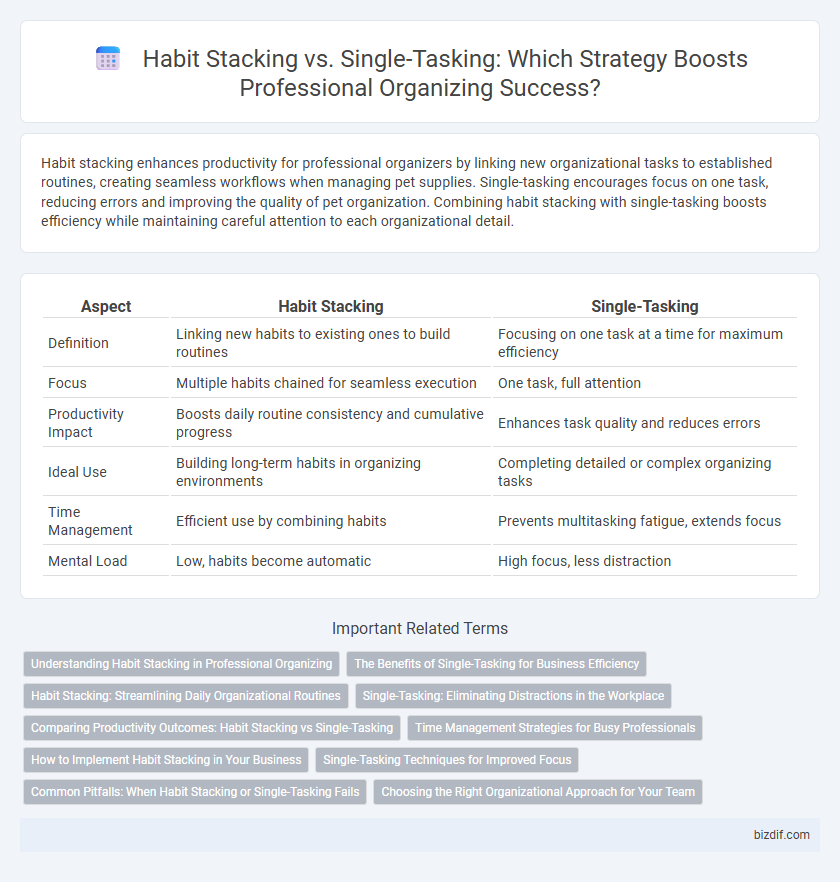Habit stacking enhances productivity for professional organizers by linking new organizational tasks to established routines, creating seamless workflows when managing pet supplies. Single-tasking encourages focus on one task, reducing errors and improving the quality of pet organization. Combining habit stacking with single-tasking boosts efficiency while maintaining careful attention to each organizational detail.
Table of Comparison
| Aspect | Habit Stacking | Single-Tasking |
|---|---|---|
| Definition | Linking new habits to existing ones to build routines | Focusing on one task at a time for maximum efficiency |
| Focus | Multiple habits chained for seamless execution | One task, full attention |
| Productivity Impact | Boosts daily routine consistency and cumulative progress | Enhances task quality and reduces errors |
| Ideal Use | Building long-term habits in organizing environments | Completing detailed or complex organizing tasks |
| Time Management | Efficient use by combining habits | Prevents multitasking fatigue, extends focus |
| Mental Load | Low, habits become automatic | High focus, less distraction |
Understanding Habit Stacking in Professional Organizing
Habit stacking in professional organizing leverages the natural flow of existing routines to seamlessly integrate new organizational habits, making behavior change more sustainable. By attaching a new task to an established habit, such as sorting paperwork immediately after morning coffee, individuals enhance efficiency and reduce decision fatigue. This approach contrasts with single-tasking, which isolates tasks but may lack the contextual cues that habit stacking provides for lasting organizational improvements.
The Benefits of Single-Tasking for Business Efficiency
Single-tasking enhances business efficiency by allowing professionals to focus deeply on one task, reducing errors and increasing productivity. Habit stacking can create routines but may lead to divided attention, whereas single-tasking promotes clarity and faster decision-making. Emphasizing single-tasking in professional organizing improves workflow management and leads to higher-quality outcomes.
Habit Stacking: Streamlining Daily Organizational Routines
Habit stacking enhances productivity by linking new organizational habits to established routines, creating seamless transitions between tasks. This method leverages context cues to reduce decision fatigue and reinforce consistency, making daily decluttering and time management more efficient. By integrating multiple small actions into a single workflow, habit stacking transforms scattered efforts into a cohesive, streamlined organizational system.
Single-Tasking: Eliminating Distractions in the Workplace
Single-tasking enhances productivity by eliminating distractions and allowing complete focus on one task at a time, significantly reducing cognitive overload. Research shows that multitasking can decrease efficiency by up to 40%, whereas single-tasking improves accuracy and work quality. Implementing single-tasking techniques in professional organizing fosters a more organized workspace and supports sustained attention for complex projects.
Comparing Productivity Outcomes: Habit Stacking vs Single-Tasking
Habit stacking enhances productivity by linking small tasks into a continuous routine, leveraging cognitive momentum to reduce decision fatigue and increase task completion rates. Single-tasking improves focus and accuracy by dedicating uninterrupted attention to one task, minimizing errors and cognitive overload. Comparatively, habit stacking suits repetitive, low-complexity activities, whereas single-tasking excels in high-focus, detail-oriented assignments, making each method effective based on task nature and professional organizing goals.
Time Management Strategies for Busy Professionals
Habit stacking enhances time management for busy professionals by linking small tasks to existing routines, increasing efficiency and reducing decision fatigue. Single-tasking improves focus and quality of work by dedicating uninterrupted time to one task, minimizing errors and boosting productivity. Combining habit stacking with strategic single-tasking allows optimal use of limited time through structured routines and deep focus.
How to Implement Habit Stacking in Your Business
Implement habit stacking in your business by identifying small, actionable tasks that naturally follow existing routines, such as reviewing client appointments immediately after checking emails. Establish clear triggers for each new habit to create automatic progression without overwhelming your workflow. Consistently track and adjust stacked habits to optimize efficiency and steadily enhance organizational productivity.
Single-Tasking Techniques for Improved Focus
Single-tasking techniques enhance focus by encouraging individuals to dedicate their full attention to one task at a time, minimizing distractions and cognitive overload. Techniques such as time blocking, the Pomodoro method, and eliminating multitasking triggers help maintain concentration and improve productivity. Consistently practicing single-tasking builds mental clarity and leads to more efficient completion of tasks in professional organizing.
Common Pitfalls: When Habit Stacking or Single-Tasking Fails
Common pitfalls in habit stacking include overwhelming the brain with too many actions at once, leading to decreased focus and eventual abandonment of the routine. Single-tasking failures often stem from unclear priorities or distractions, which disrupt the flow and reduce productivity. Both approaches require consistent evaluation and adjustments to ensure habit sustainability and effective time management in professional organizing.
Choosing the Right Organizational Approach for Your Team
Habit stacking leverages the power of linking small organizational tasks to existing routines, enhancing team productivity by creating seamless workflows. Single-tasking emphasizes focused attention on one task at a time, reducing errors and improving quality of work within team projects. Selecting the appropriate approach depends on your team's work style, complexity of tasks, and priority for efficiency or accuracy in professional organizing.
habit stacking vs single-tasking Infographic

 bizdif.com
bizdif.com